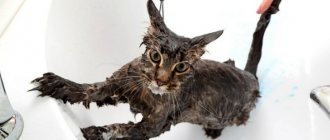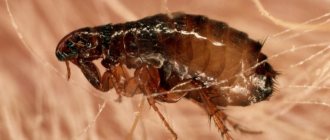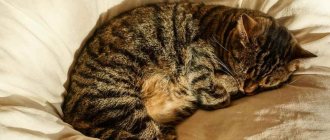One of the most dangerous types of injury is a burn in a cat. Veterinarians distinguish several types of the condition depending on the triggering factors. The damage has 3 degrees of severity and is accompanied by redness, blistering, wound formation or tissue death. The owner should provide proper first aid and take the pet to the veterinarian. The doctor will prescribe treatment and give preventive recommendations.
According to veterinary anesthesiologist A. Maltseva, if the burn exceeds 50% of the cat’s skin area, the prognosis is poor, and when it is less than 15%, then the chances of a complete cure are high.
Types and degrees of burns
The reasons for getting burns can be different. Careless behavior of the owners and active curiosity of the cat can lead to injury. Your pet may suffer the following burns:
- thermal,
- chemical,
- sunny.
Thermal burns are the most common option. You can accidentally spill a hot drink or food on a cat that accidentally gets under your feet. She may show excessive curiosity, “touch” the iron, tiles, jump onto a hot surface, etc.
Chemical burns are the result of contact with liquids containing acids or alkalis. The likelihood of such injury occurs if the storage rules for these dangerous drugs are not followed.
Sunburn can occur from prolonged exposure to direct sunlight. They affect mainly hairless breeds. These pets need protection from intense exposure to ultraviolet radiation.
All burns according to the scale and depth of damage to the skin are classified into 3 degrees:
- I degree is characterized by minor damage to the upper layers of the skin, redness and slight swelling are observed;
- Stage II affects the middle layers of the dermis, causing blisters to appear, which will gradually break through;
- Grade III is the most severe, causing complete damage to the structure of the integument, accompanied by tissue necrosis.
How to recognize a burn?
External damage
If the animal’s condition is caused by sun activity, then a characteristic dermatosis appears on its skin.
When exposed to chemical solutions, the animal feels severe pain, rushes about, screams, and the skin or mucous membranes turn red. Electrical trauma is manifested by swelling of the upper respiratory organs, difficulty breathing, paralysis of the paws, and impaired cardiac and brain activity. When the eyes are burned, there is lacrimation, swelling of the eyelids, and the cat squints unnaturally. With solar dermatosis, peeling and erythema appear. If a cat burns its paw, body, or accidentally gets boiling water on it, veterinarians distinguish 3 degrees of severity of damage, the symptoms of which are shown in the table:
| Degree | Signs |
| Lightweight | Severe pain |
| Redness of the burned area | |
| Swelling | |
| Minor hyperthermia | |
| The dark footpad becomes whitish, pink or white becomes dark pink or red. | |
| Average | Pain, hyperemia, swelling |
| The appearance of bubbles with clear liquid | |
| Formation of crusts after opening of the bubble and leakage of liquid | |
| Hair loss | |
| Fever, refusal to eat | |
| Heavy | The deep layers of the dermis are affected |
| Carbonization and tissue death | |
| Lack of fur, paws peel off and claws fall out | |
| Temperature increase | |
| Lethargy, apathy, lack of appetite | |
| Vomiting as the body's reaction to pain and intoxication | |
| Bacterial infection and death |
Signs of a burn to internal organs
With such an injury, the animal can breathe with its mouth open.
When toxic chemicals or flammable substances are ingested, as well as from electrical burns in animals, the mucous membranes of the mouth, throat, esophagus, stomach, and brain are affected. Therefore, depending on the cause of the damage, the following symptoms are observed:
- difficult and frequent breathing, sometimes with an open mouth;
- coughing or sneezing;
- impaired or absent swallowing function;
- vomiting blood;
- convulsions;
- paw paresis;
- severe pain, but the animal may remain silent due to pain shock;
- disturbance of heart rhythm and coordination of movements;
- fainting.
Help with thermal burns
First degree thermal burns, resulting from accidental contact with hot liquids on the skin or contact with hot objects, are accompanied by pain, redness of the skin, and the appearance of small tumors. In such cases, the help of a professional veterinarian is not required; the skin will completely recover in a few days. But the pet needs to be provided with proper care, to prevent infection, and to speed up healing.
It is important to remember that you cannot cover the burned surface with plasters, napkins, or bandages. First, the injured area should be cooled with water for five minutes. Then it should be disinfected with a weak solution of potassium permanganate. Every day, until the wound heals, it must be treated three times. You can use for this:
- Terricin spray;
- aerosol Panthenol or Alazol.
- Traumeel gel
When exposed to fatty, thick hot food, pets often suffer second-degree burns. In this case, the hair in the damaged area falls out, the skin becomes brown, and blisters appear. In this case, you first need to remove any remaining food from the animal and cool the skin well. You can hold your pet under running cold water or attach a bag with ice in it.
Such burns cause severe pain; the cat must be given an injection of an anesthetic drug. The burned dermis should be treated with an intensive solution of potassium permanganate or an alcohol tincture of propolis. After distributing the gel, spray or aerosol, apply a sterile napkin or bandage. The dressing should be changed daily.
A third degree burn poses a danger to the life of the animal. There is a high risk of developing sepsis. Such an injury is indicated by blackened skin and lost hair. First aid, including cooling, disinfection, and application of special medications, must be provided. But after this you should immediately contact a veterinary hospital.
What to do if the cat gets burned?
First aid
If an animal receives a thermal injury, the owner can use Panthenol.
At home, the owner must be able to assist the pet, since the animal’s life depends on it. Depending on the type of burn injury, first aid is provided as follows:
- Thermal:
- Apply Panthenol to the burnt area.
- Apply a cold compress for 15 minutes.
- Apply a sterile bandage.
- Inject the drug "Ketolong".
- Chemical:
- Neutralize the acid with soda solution.
- Prevent the effect of alkali with a weak solution of vinegar.
- Treat the affected area with diluted potassium permanganate, Furacilin.
- Electric:
- Turn off the power supply.
- Pull the pet away with a wooden mop or broom without metal fasteners.
- Take him to the veterinary clinic immediately, as cardiac arrest is possible.
- Eye burn:
- Rinse the organ with cool running water.
- Apply a sterile bandage to the eye.
- Solar:
- Keep your cat away from direct ultraviolet rays.
- Apply sunscreen with titanium dioxide.
Drug treatment
The animal can be given only those drugs that the doctor has selected for it.
All medications are prescribed by a veterinarian; it is prohibited to treat your cat yourself at home. Thermal burns of a cat's paw pads or other parts of the body can be cured with veterinary medications from the following groups:
- antibiotics;
- steroid medications;
- wound healing liniments;
- painkillers;
- anti-inflammatory.
For solar dermatitis, when the ears and natural bald spots near them are burned, retinoids, vitamin A, and P-carotene are used for treatment. For eye burns, bactericidal, decongestant and anti-inflammatory drugs are prescribed to prevent secondary infection. It is recommended to wear a sterile bandage, blanket or protective collar until the injuries heal.
Surgical intervention
If an animal's limbs are severely damaged, they are removed.
The operation must be done if the animal has a terminal stage of thermal burn. Dead tissue is removed; in severe cases, amputation of the damaged limb is performed. If the burn provokes laryngeal stenosis, a tracheostomy is performed, in which a T-shaped tube is installed in the trachea. Sometimes oxygen therapy sessions are required or the animal is connected to a ventilator. If the cat has burned the mucous membranes of the mouth and throat, after intensive therapy the cat should be fed through a tube or intravenously.
Help with chemical burns
Substances containing alkali or acid destroy the structure of the skin. The weakening of the protective cover opens access to pathogenic microbes and bacteria. The peculiarity of chemical burns is the duration of exposure. Even after removing the substance from the upper layers of the dermis, it remains in the middle, deep tissues; high-quality neutralization is required to prevent further destruction and poisoning of the body.
First of all, in case of a chemical burn, it is necessary to thoroughly wash the damaged area. The procedure should be carried out with gloves to prevent damage to the skin of the hands. The neutralizing agent is selected taking into account the specifics of the substance that caused the burn. Among them may be:
- alkali,
- acid,
- quicklime.
If an animal is exposed to a substance containing an alkali, acids are used in neutralization. This can be a solution of vinegar or citric acid. A napkin is moistened in it and applied to the damaged area. As it dries, it needs to be moistened. For burns with acidic compounds, the principle of action is the same, only a solution of baking soda is used in neutralization. If quicklime gets on the skin, the affected area is generously lubricated with sea buckthorn, castor, and sunflower oil.
Burn in a cat - types of injuries and assistance to the pet
One of the most dangerous types of injury is a burn in a cat. Veterinarians distinguish several types of the condition depending on the triggering factors. The damage has 3 degrees of severity and is accompanied by redness, blistering, wound formation or tissue death. The owner should provide proper first aid and take the pet to the veterinarian. The doctor will prescribe treatment and give preventive recommendations.
According to veterinary anesthesiologist A. Maltseva, if the burn exceeds 50% of the cat’s skin area, the prognosis is poor, and when it is less than 15%, then the chances of a complete cure are high.
Help with sunburn
Prolonged exposure to direct sunlight can cause a lot of harm to pets of hairless breeds, as well as white cats with short hair. The consequences of sunburn are:
- sore tips of the ears,
- bald areas,
- small sores.
In most cases, the help of a qualified veterinarian is not required. The effects of active exposure to ultraviolet rays can be eliminated within a few days. To do this, Saphroderm or Eplan are applied to the affected areas.
You should not endanger your beloved hairless pet. It is necessary to provide it with protection from direct sunlight.
Internal burns of mucous membranes
Stitches, wounds, scratches and other injuries in cats are not treated with brilliant green. When licked, brilliant green affects the tongue, esophagus, and stomach - a chemical burn. If a cat has a burn from brilliant green, give the animal Enterosgel or any available absorbent and immediately contact a veterinarian.
Food burns cause a lot of discomfort, but most often, the epithelium is restored within 10–12 hours. The situation is much more serious if the pet died in a fire. In addition to inhalation of carcinogenic gases, burns of the mucous tract are observed.
A burn to the nasal mucosa in a cat is accompanied by sneezing with the release of mucus and soot, coughing, and shortness of breath. To understand how to treat a cat, you need to identify the depth of the lesion; as first aid, the animal is given a subcutaneous injection of an immunostimulant and an anesthetic drug. An old but proven method - intravenous administration of a veterinary aqueous solution of methylene blue with glucose - quickly restores hemoglobin levels, 0.10–0.15 ml per 1 kg of animal weight.
Specifics of eye burns
Eye burns are especially dangerous. They can occur when hot drops or chemicals come into contact with the mucous membrane, or when a toxic agent is accidentally used instead of medicine. Help for the animal must be provided immediately.
First, the mucous membrane is thoroughly washed under running cold water with low pressure. The cat will most likely try to close his eyes. You need to spread the eyelids with your fingers, trying not to cause pain to your pet. No improvised means should be used to treat burned eyes. The cat must be taken to a veterinary hospital.
Classification of burns in cats
Based on the underlying causes, burns are divided into three categories. By type, burns are divided into:
- Thermal - hot water, steam, fire, hot asphalt.
- Chemical – alkalis, acids, gas, medicines, alcohol.
- Radiation – exposure, including ultraviolet rays – sunburn.
According to localization they distinguish:
- External – skin damage, including burns to the cat’s paw pads.
- Internal – damage to the esophagus, tongue, stomach, upper respiratory tract, lungs.
- Damage to mucous membranes - eyes, nose, genital area and all types of internal burns.
You need to be able to distinguish a mucosal burn from an irritation or an allergic reaction. The most common causes of burns to mucous membranes are feeding hot food or inhaling smoke from a fire. External burns are most often classified according to the degree of damage: I, II and III degree.
The technique of providing assistance depends on the location of the lesion and has several techniques. Of course, the best option is when the help is provided by a professional - there is a better chance of preserving the skin and tissue. However, more often than not, an event occurs at the most inopportune moment and all responsibility falls on the shoulders of the owners.











